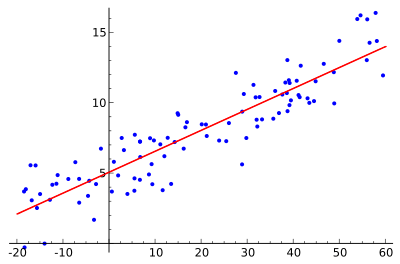Arellano–Bond estimator
| Part of a series on Statistics |
| Regression analysis |
|---|
 |
| Models |
| Estimation |
| Background |
|
In econometrics, the Arellano–Bond estimator is a generalized method of moments estimator used to estimate dynamic panel data models. It was first proposed by Manuel Arellano and Stephen Bond in 1991.[1]
Qualitative description
Unlike static panel data models, dynamic panel data models include lagged levels of the dependent variable as regressors. Since lags of the dependent variable are necessarily correlated with the idiosyncratic error, traditional static panel data model estimators such as the fixed effects and random effects estimators are inconsistent, due to presence of endogenous regressors.
Anderson and Hsaio (1981) first proposed a solution by utilising instrumental variables (IV) estimation.[2] By taking the first difference of the regression equation to eliminate the fixed effect, deeper lags of the dependent variable can be used as instruments for differenced lags of the dependent variable (which are endogenous). Since increasing the number of instruments always increases the asymptotic efficiency of the estimator, it was proposed that all instruments in each time period should be used.
However, the Anderson–Hsiao estimator is asymptotically inefficient, as its asymptotic variance is higher than the Arellano–Bond estimator, which uses the same set of instruments, but constructs moment conditions from them and uses generalized method of moments estimation rather than instrumental variables estimation.
Formal description
Consider the static linear unobserved effects model for observations and time periods:
- for and
where is the dependent variable observed for individual at time is the time-variant regressor matrix, is the unobserved time-invariant individual effect and is the error term. Unlike , cannot be observed by the econometrician. Common examples for time-invariant effects are innate ability for individuals or historical and institutional factors for countries.
Unlike a static panel data model, a dynamic panel model also contains lags of the dependent variable as regressors, accounting for concepts such as momentum and inertia. In addition to the regressors outlined above, consider a case where one lag of the dependent variable is included as a regressor, .
- for and
Taking the first difference of this equation to eliminate the fixed effect,
- for and
This equation can be re-written as,
Applying the formula for the Efficient Generalized Method of Moments Estimator, which is,
where is the instrument matrix for .
The matrix can be calculated from the variance of the error terms, for the one-step Arellano–Bond estimator or using the residual vectors of the one-step Arellano–Bond estimator for the two-step Arellano–Bond estimator, which is consistent and asymptotically efficient in the presence of heteroskedasticity.
Implementations in statistics packages
- R: the Arellano–Bond estimator is available as part of the
plmpackage.[3][4][5] - Stata: the commands
xtabondandxtabond2return Arellano–Bond estimators.[6][7]
See also
References
- ↑ Arellano, Manuel; Bond, Stephen (1991). "Some tests of specification for panel data: Monte Carlo evidence and an application to employment equations". Review of Economic Studies. 58 (2): 277. doi:10.2307/2297968. JSTOR 2297968..
- ↑ Anderson, T. W.; Hsiao, Cheng (1981). "Estimation of dynamic models with error components". Journal of the American Statistical Association. 76 (375): 598–606. doi:10.1080/01621459.1981.10477691..
- ↑ Kleiber, Christian; Zeileis, Achim (2008). "Linear Regression with Panel Data". Applied Econometrics with R. Springer. pp. 84–89. ISBN 978-0-387-77316-2.
- ↑ Croissant, Yves; Millo, Giovanni (2008). "Panel Data Econometrics in R: The plm Package". Journal of Statistical Software. 27 (2): 1–43.
- ↑ "plm: Linear Models for Panel Data". R Project.
- ↑ "xtabond — Arellano–Bond linear dynamic panel-data estimation" (PDF). Stata Manual.
- ↑ "Roodman, R: How to do xtabond2: An introduction to difference and system GMM in Stata". Stata Journal, vol. 9(1), pp. 86-136.
Further reading
- Cameron, A. Colin; Trivedi, Pravin K. (2005). "Dynamic Models". Microeconometrics: Methods and Applications. New York: Cambridge University Press. pp. 763–768. ISBN 0-521-84805-9.
- Hsiao, Cheng (2014). "Dynamic Simultaneous Equations Models". Analysis of Panel Data. New York: Cambridge University Press. pp. 397–402. ISBN 978-1-107-65763-2.